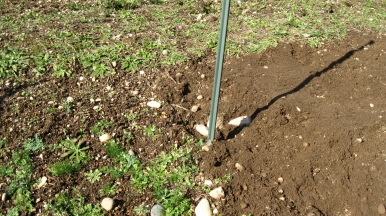The sun is out. So is the wind. It is a wonderful Northwest winter day that feels so much like spring. The chance to work the vines … That’s a happy day.
I decided last year to prune with clean tools this is an excellent way to keep the vines clean and prevent the spread of pathogens (fungus, mildew, bacteria, etc.) I used alcohol dips coupled with a flame from my handy-dandy Coleman blow torch… after every cut.While this does effectively prevent the spread of crud and clean even pitted blades, it is labor intensive because the breezy winds keep blowing out the flame. Lots of matches later the job was done.
This year I chose to disinfect my tools another way. I put on plastic gloves which didn’t work… my hands will smell like cleaner for a while. 😦
I ran the hose out to the lower part of the vineyard and got out the Lysol concentrate to dip a rag in. After sudsing up my clippers, waiting 5 minutes and thoroughly rinsing them, I was ready for the first cut. (Lysol really stinks and I would never use it in my home.) I found that Lysol is the disinfectant of choice with several growers from different online articles. A clean vineyard is important. Why shouldn’t it be important here?
Beginning with the uppermost vine (the end of row 1), I cut all laterals and any stubs at the base of the trunk as per Jeff Cox’s advice in From Vines to Wines page 60.
Instead of cleaning the clippers after every cut, I cleaned them after all cuts were made for each vine. Some may think I’m over the top about cleaning tools but I really think I’ve chosen a doable compromise.
These vines have been in the ground a long time (since 2009) but I am pruning them as if they were first year growth only. In a way they are. They have exactly one year’s healthy growth on them after I cut them all the way to the ground the year before that — Oh, what a heartache that was!
Marechal Foch is supposed to be disease resistant but we have had troubles with shall we call it…non-normal growth events. I call it that because it is difficult to find answers.
This year I found darkened bark with long spaces of whitened bark along with white spores and a gray stuff on growth a ways out from the trunk which is usually a sign of powdery mildew. When cutting away old stubs, I also found evidence of abnormalities beneath the bark — a v-shaped dead wood event — on the number 2 vine in the row. (May the LORD who is the True Vine, heal these vines for his glory. Amen.)
Another reason for treating the vines as though they are one year old is the lack of support waiting for them. All they have right now are end posts and fruiting wires. They need in-line posts and catch wires but that costs money we don’t have right now so it will have to wait. If I had it to do over again and money was no object, I would place every bit of the trellis up before one plant went into the ground. Oh well. Onward and forward.

My husband, Steve Webster, and I cut down and scraped the bark off each fir tree end post from timber on our own property.
We call this vineyard Weaver’s Hill. Actually it should be called Shoestring Hill. We dove into this project on a shoestring and continue it in the same manner. All monies for vineyard steps have been accomplished with little or no money at all. We invested small amounts as we had extra to put into it. Not so bad for a classroom but also not so great for a wine project.
I suppose we could even go with the moniker – On a wing and a prayer. 🙂
Keeping pruning simple this year allows me to get the fruiting wire straight and the other elements of trellising worked on. Hopefully, I will be able to get that done before bud break in April.
LORD, please grant me more gardening days and resources to bring this vineyard around so that it will honor you. Amen.
P.S. I can trade Crochet lessons or items for Vineyard needs. This is, after all, Weaver’s Hill 🙂 If you are interested, or know someone who might be, contact me @ cjwebster39@aol.com and put Weaver’s Hill in the subject line. Thank you and God Bless.































